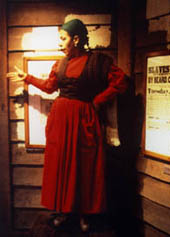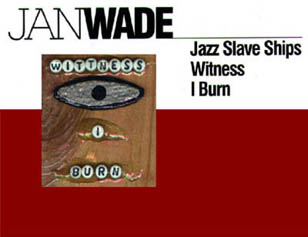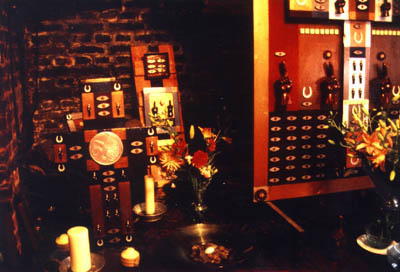

|
Jazz Slave Ships, Witness, I Burn was a site-specific performance
collaboration between Vancouver artist Jan Wade and London-based performer
Vanessa Richards that involved the creation of an ancestral altar. It took
place in two U.K. ports in October 1996: on the West Coast in Whitehaven,
Cumbria (the last English slaving port), in an 18th century bonded warehouse
used to store liquor and guns used in the slave trade; and on the East Coast
in Hull, Yorkshire in Wilberforce House, the birthplace of the anti-slavery
pioneer William Wilberforce and now a museum of anti-slavery and its
artifacts. The production took place over a 3-week period that commenced
Sept.
30, 1996. Wade's work focussed on altars as vehicles for worship, vessels of African spirituality and for reconciling the painful past of the African Diaspora.. She created altars using objects relating to Black spirituality in the practice of santeria (a mixture of Yoruban spirituality and New World Catholicism). The site in Whitehaven was an 18th century liquor merchants' warehouse on the docks still owned by the Jefferson sisters, descendants of the same family that built it, and with direct links to the slave trade. The idea was that a space used to enslave the ancestors was cleansed by the process of creating the altar within it. The 3-dimensional altars were constructed of wood found on the sites. The reference was to the African practice that whenever a drum or votive object was created, they would use wood from a tree closest to the village as that tree would hold the village's stories. The wood that Wade found at the sites was believed to contain the voices and stories of those villages. There were man-made objects such as horseshoes, hands, 8-balls, dolls, acrylic paint and organic elements like shells and rocks, incense, fire and music. The finished 3-D sculptures were approximately 10' x 4'. The altars were then lowered into water for a symbolic voyage back to Africa. In Whitehaven it was into the Irish Sea, and in Hull it was the pond in the Nelson Mandela commemorative garden adjacent to the museum. This was following the African custom of sacrificing ancestral objects to the sea, the water being the home of the spirit world. During the voyages to slavery in the New World, many captives chose to jump over board where they believed the ancestors and spirits lived. Under the mirrored surface of the water, they would be returned home to Africa. Sacrificing the ancestral altars to the sea was seen as a holistic act of acknowledgement and remembering. These acts were accompanied by a performance. The performance is an important element in the African tradition of producing ritual objects, altars, or drums would involve a ceremony of song and storytelling. These actions were required for the objects to be sanctified and made relevant to the community. Vanessa Richards, a performance poet originally from Vancouver, acted as Wade's griot (storyteller). Jazz Slave Ships was presented in conjunction with the "Year of Visual Art in the North of England" - a series of international exhibitions from March to November 1996, and Black History Month in the U.K. Like all our recent projects, this one developed from the last one, a video installation at Exchange Resources Belfast in Nov. 1995. We featured two videotapes by Paul Wong, documenting the work of Nhan Duc Nguyen in Belfast in September, 1994, and Philip Napier, a Belfast artist who we hosted in Vancouver, Oct. 1995. We had collaborated with Locus + and the success of these past projects inspired this one. A co-production by On Edge (Vancouver) and Locus + (Newcastle). |
